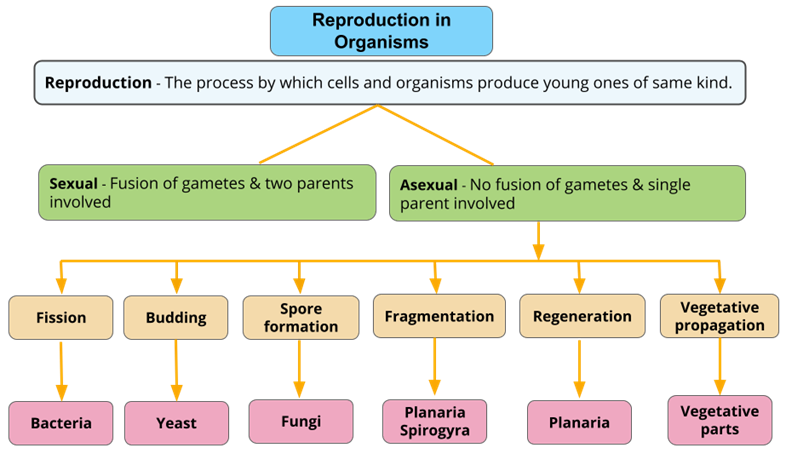PDF chapter test TRY NOW
Let us now discuss the life processes in detail.
Growth:
Growth is the increase in the mass of an organism. In unicellular organisms, growth occurs through an increase in the cell's size and also through cell division. Cell division in unicellular organisms is through reproduction. On the contrary, in multicellular organisms, growth occurs through an increase in the number of cells by cell division.
In plants, growth occurs throughout their life, while in animals, growth occurs until a certain age, after which cells divide to replace worn out and repaired cells.
- Living organisms show internal growth due to the production of cells inside the body, and it's called intussusception.
- Non-living things like rock, stone, mountains too increase in size. Here there is the addition of materials on the outer surface, and it's known as accretion.
Metabolism:
The sum total of chemical reactions inside the cells due to the interactions with the molecules is called metabolism.
All the activities of an organism including growth, development, reproduction, consciousness etc., are caused due to metabolism. On the other hand, non-living objects do not display metabolism, and thus it is a defining property of living beings.
Metabolism is of two types:
1. Catabolism
2. Anabolism

Types of metabolism
Catabolism:
Catabolism involves the breakdown of complex substances (polymers) into simpler substances (monomers), and it's also known as destructive metabolism. The example includes respiration. During this process, the energy is released that can utilise for performing other activities of the body.
Anabolism:
Anabolism involves the synthesis of complex substances (polymers) from simpler substances (monomers). These are "building up reactions" and also called constructive metabolism.
The example includes synthesis of organic compounds from CO_2 and H_2O during photosynthesis, synthesis of starch from glucose, production of proteins from amino acids and synthesis of lipids from fatty acids and glycerol. Anabolism stores energy.

Anabolism and catabolism
Movement:
Living beings move on their own from place to place, and it is termed as locomotion.
Non-living things cannot move by themselves, and they need some external force to move them. For example, a stone is a non-living thing and cannot move by itself. Another example, a car or bus is also a non-living thing, but they can drive them.
Animals like frog jumps, dogs and human locomote with the help of limbs. However, while in plants, the movements are slow and cannot be easily identifiable by us.
The plants are fixed to the soil and cannot move like animals. Plants can only move their parts - leaves, flowers, shoot and root. However, plant parts can move towards stimulus, and a phenomenon called tropism.
Important!
Is virus living or non-living? Since they do not show any visible movements until it infects other organisms, some consider it non-living. In contrast, some consider it as living. However, there are still controversies among scientists about whether they are considered living or not.
Reproduction:
Reproduction is the formation of new individuals of a similar kind. New individuals are copies of the parent or existing organism. It is not essential for the individual's survival, but it is required for the continuation of a species and helps in increasing the individuals in a population.

Types of reproduction
Reproduction is of two types:
1. Asexual reproduction - Production of new individuals from a single parent (uniparental) without the fusion of gametes. The process of asexual reproduction occurs through:
a. Binary fission - occurs in bacteria like Amoeba, Paramecium, Euglena, Bacillus subtilis, Escherichia coli.

Binary fission in bacteria
b. Fragmentation - occurs in green algae like Spirogyra, fungi, cyanobacteria, animals including flatworms, star fish, Planaria, sponges etc.

Fragmentation in Spirogyra

Fragmentation in Planaria
c. Budding - occurs in corals, bacteria like Saccharomyces cerevisiae (yeast), Hydra, sea anemones,

Budding in yeast

Budding observed in hydra
d. Spore formation - occurs in bread molds (Rhizopus), Mucor etc.

Spore formation in fungi
2. Sexual reproduction - Production of new individuals from the fusion of two types of gametes or sex cells (biparental). Fusion of gametes result in the formation of a zygote which gives rise to offspring.
In unicellular organisms, growth and reproduction are similar. Few organisms like mules, sterile worker bees do not reproduce. Thus, it is not a defining property of living beings.
Other life processes like nutrition, respiration, transportation and excretion are discussed in detail in the following theories.
Reference:
https://commons.wikimedia.org/wiki/File:Binary_Fission_2.svg
https://upload.wikimedia.org/wikipedia/commons/6/62/Figure_43_01_02.jpg
https://commons.wikimedia.org/wiki/File:103_Metabolism.jpg
